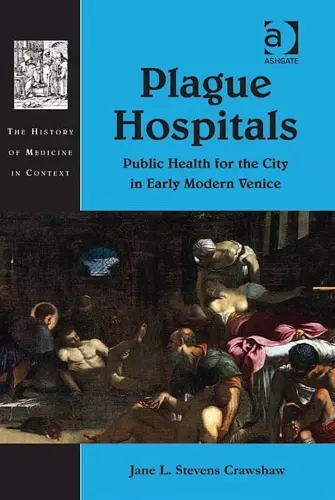Plague Hospitals
Public Health for the City in Early Modern Venice
Jane L Stevens Crawshaw author
Format:Hardback
Publisher:Taylor & Francis Ltd
Published:28th Dec '12
Currently unavailable, and unfortunately no date known when it will be back
This hardback is available in another edition too:
- Paperback£56.99(9781138245891)

Developed throughout early modern Europe, lazaretti, or plague hospitals, took on a central role in early modern responses to epidemic disease, in particular the prevention and treatment of plague. The lazaretti served as isolation hospitals, quarantine centres, convalescent homes, cemeteries, and depots for the disinfection or destruction of infected goods. The first permanent example of this institution was established in Venice in 1423 and between the fifteenth and eighteenth centuries tens of thousands of patients passed through the doors. Founded on lagoon islands, the lazaretti tell us about the relationship between the city and its natural environment. The plague hospitals also illustrate the way in which medical structures in Venice intersected with those of piety and poor relief and provided a model for public health which was influential across Europe. This is the first detailed study of how these plague hospitals functioned, where they were situated, who worked there, what it was like to stay there, and how many people survived. Comparisons are made between the Venetian lazaretti and similar institutions in Padua, Verona and other Italian and European cities. Centred on the sixteenth and seventeenth centuries, during which time there were both serious plague outbreaks in Europe and periods of relative calm, the book explores what the lazaretti can tell us about early modern medicine and society and makes a significant contribution to both Venetian history and our understanding of public health in early modern Europe, engaging with ideas of infection and isolation, charity and cure, dirt, disease and death.
'The author of this study has produced a very readable and useful work. ... This is a very good study of plague hospitals and one that thoughtfully comments on the major themes on plague studies and medical history at the end of the Middle Ages. Venetian historians will find the hospitals carefully integrated into the world they study, and more general readers will find an excellent summary work on medicine and public health in the early modern period.' Duane J. Osheim, The Historian 'In this carefully researched and engaging study, Jane L. Stevens Crawshaw offers a focused and multifaceted history of Venice’s two iconic lazaretti, or plague hospitals ... Plague Hospitals should serve as a model for how to research and write about complex and multifaceted institutions in relation to the specific social and political contexts in which they operated.' Renaissance & Reformation '... Crawshaw offers considerably more than a singular case study of Venetian lazarettos, sustaining detail of an astonishing array and depth.' The Medieval Review 'Crawshaw’s analysis raises interesting questions for the study of hospitals, epidemiology, as well as the function of charity in early modern societies. ... [her research] will hopefully reinvigorate the field by proving that there are still many materials to analyse and questions to ask about the plague and public health in early modern Europe.' Sixteenth Century Journal '... this book makes a significant contribution to the history of hospitals and the history of medicine more broadly.' Renaissance Quarterly
ISBN: 9780754669586
Dimensions: unknown
Weight: 793g
338 pages